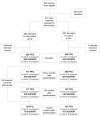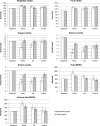Effects of a preconception lifestyle intervention in obese infertile women on diet and physical activity; A secondary analysis of a randomized controlled trial
- PMID: 30403756
- PMCID: PMC6221548
- DOI: 10.1371/journal.pone.0206888
Effects of a preconception lifestyle intervention in obese infertile women on diet and physical activity; A secondary analysis of a randomized controlled trial
Abstract
Background: Lifestyle changes are notoriously difficult. Since women who intend to become pregnant are more susceptible to lifestyle advice, interventions during this time window might be more effective than interventions during any other period in life. We here report the effects of the first large preconception lifestyle intervention RCT on diet and physical activity in obese infertile women.
Methods: In total, 577 women were randomized between a six-month lifestyle intervention program (intervention group; N = 290) or prompt infertility treatment (control group; N = 287). Self-reported dietary behaviors and physical activity were assessed at baseline, three, six and twelve months after randomization. Mixed models were used to analyze differences between groups.
Results: Compared to the control group, the intervention group reduced their intake of sugary drinks at three months (-0.5 glasses/day [95% C.I. = -0.9;-0.2]), of savory snacks at three (-2.4 handful/week [-3.4;-1.4]) and at six months (-1.4 handful/week [-2.6;-0.2]), and of sweet snacks at three (-2.2 portion/week [-3.3;-1.0]) and twelve months after randomization (-1.9 portion/week [-3.5;-0.4]). Also, the intervention group was more moderate to vigorous physically active at three months after randomization compared to the control group (169.0 minutes/week [6.0; 332.1]).
Conclusion: Our study showed that obese infertile women who followed a six-month preconception lifestyle intervention program decreased their intake of high caloric snacks and beverages, and increased their physical activity. These changes in lifestyle may not only improve women's health but their offspring's health too.
Conflict of interest statement
The authors have read the journal's policy and the authors of this manuscript have the following competing interests: The department of Obstetrics and Gynaecology of the UMCG received an unrestricted educational grant from Ferring pharmaceuticals BV, The Netherlands, outside the submitted work (Prof. Dr. A. Hoek). Prof. Dr. B.W. Mol is supported by a NHMRC Practitioner Fellowship (GNT1082548) and reports consultancy for ObsEva, Merck Merck KGaA and Guerbet. This does not alter our adherence to PLOS ONE policies on sharing data and materials. All other authors declare that they have no competing interests.
Figures


Similar articles
-
Preconception lifestyle intervention reduces long term energy intake in women with obesity and infertility: a randomised controlled trial.Int J Behav Nutr Phys Act. 2019 Jan 8;16(1):3. doi: 10.1186/s12966-018-0761-6. Int J Behav Nutr Phys Act. 2019. PMID: 30621789 Free PMC article. Clinical Trial.
-
Effectiveness of lifestyle intervention in subgroups of obese infertile women: a subgroup analysis of a RCT.Hum Reprod. 2016 Dec;31(12):2704-2713. doi: 10.1093/humrep/dew252. Epub 2016 Oct 19. Hum Reprod. 2016. PMID: 27798042 Clinical Trial.
-
Cost-effectiveness analysis of lifestyle intervention in obese infertile women.Hum Reprod. 2017 Jul 1;32(7):1418-1426. doi: 10.1093/humrep/dex092. Hum Reprod. 2017. PMID: 28486704
-
Offspring body size and metabolic profile - effects of lifestyle intervention in obese pregnant women.Dan Med J. 2014 Jul;61(7):B4893. Dan Med J. 2014. PMID: 25123127 Review.
-
The Relationship Between Pregnancy Intentions and Diet or Physical Activity Behaviors in the Preconception and Antenatal Periods: A Systematic Review and Meta-Analysis.J Midwifery Womens Health. 2020 Sep;65(5):660-680. doi: 10.1111/jmwh.13112. Epub 2020 Jun 27. J Midwifery Womens Health. 2020. PMID: 32592533
Cited by
-
Preconception Lifestyle and Cardiovascular Health in the Offspring of Overweight and Obese Women.Nutrients. 2019 Oct 14;11(10):2446. doi: 10.3390/nu11102446. Nutrients. 2019. PMID: 31615021 Free PMC article. Clinical Trial.
-
Dietary Intake, Eating Behavior, Physical Activity, and Quality of Life in Infertile Women with PCOS and Obesity Compared with Non-PCOS Obese Controls.Nutrients. 2021 Oct 8;13(10):3526. doi: 10.3390/nu13103526. Nutrients. 2021. PMID: 34684528 Free PMC article.
-
Preconception lifestyle intervention reduces long term energy intake in women with obesity and infertility: a randomised controlled trial.Int J Behav Nutr Phys Act. 2019 Jan 8;16(1):3. doi: 10.1186/s12966-018-0761-6. Int J Behav Nutr Phys Act. 2019. PMID: 30621789 Free PMC article. Clinical Trial.
-
A lifestyle intervention randomized controlled trial in obese women with infertility improved body composition among those who experienced childhood adversity.Stress Health. 2021 Feb;37(1):93-102. doi: 10.1002/smi.2976. Epub 2020 Aug 18. Stress Health. 2021. PMID: 32761731 Free PMC article. Clinical Trial.
-
Evaluating Preconception Health and Behaviour Change in Australian Women Planning a Pregnancy: The OptimalMe Program, a Digital Healthy Lifestyle Intervention with Remotely Delivered Coaching.Nutrients. 2024 Jan 3;16(1):155. doi: 10.3390/nu16010155. Nutrients. 2024. PMID: 38201984 Free PMC article.
References
-
- Yilmaz N, Kilic S, Kanat-Pektas M, Gulerman C, Mollamahmutoglu L. The Relationship between Obesity and Fecundity. J Women’s Heal. 2009;18(5):633–6. - PubMed
Publication types
MeSH terms
LinkOut - more resources
Full Text Sources
Medical

